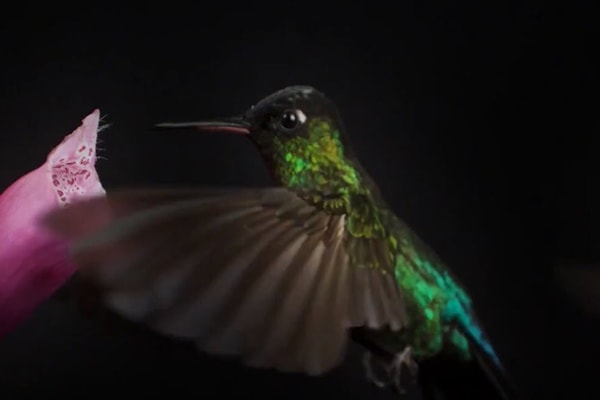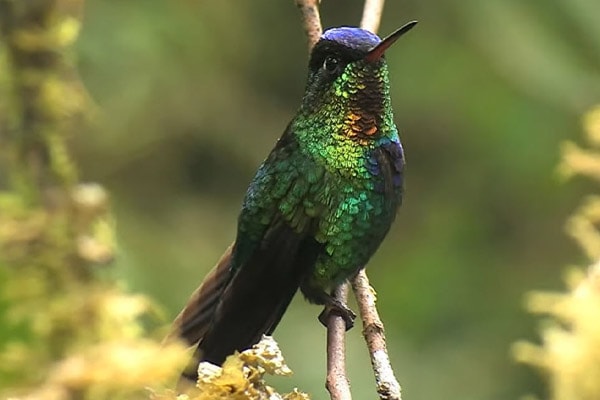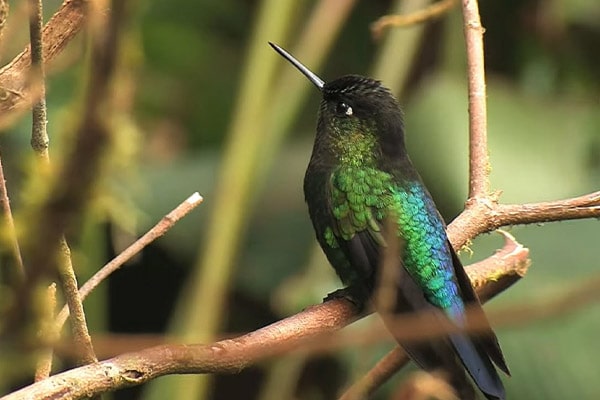Contents
- Fiery-throated hummingbird facts
- How to identify a Fiery-throated hummingbird
- Where you’ll see Fiery-throated hummingbirds
- Fiery-throated hummingbird diet and feeding preferences
- Fiery-throated hummingbird nesting
- Fiery-throated hummingbird behavior
- Conservation status of the Fiery-throated hummingbird
- Fun & Interesting Facts about the Fiery-throated hummingbird
- Explore More Species in This Family
The Fiery-throated hummingbird is a beautiful species of bird that’s best described as “Mountain Gems” because they are members of the tribe of Lampornithini, which is also part of the subfamily Trochilinae, which is their scientific family.
This bird is dazzling and enchanting, and it spends the bulk of its time living in the rainy cloud forests of Costa Rica. You can also find it throughout parts of western Panama. This bird has vibrant plumage and distinctive throat colors, and it’s such a beautiful creature that it immediately captures your attention.
Out of all of its wonderful features, the vibrant and iridescent plumage is the one that stands out the most. The male members of the species are typically the ones with brilliant and beautiful plumage combinations. Their upper parts are emerald green, while their underparts are shimmering turquoise. But its throat really stands out and captivates the imagination because it showcases a beautiful spectrum of red, orange, and yellow shining colors.
The Fiery-throated hummingbird is a small bird that is only around 4 inches in length, but that hasn’t stopped it from perfectly adapting to the cloud forest habitats in Costa Rica. It primarily feeds on the nectar of flowering plants, using its long slender bill to access the hidden delicious nectar found deep within certain tubular flowers.
Most important of all, the fiery-throated hummingbird is a breathtaking symbol of beauty and diversity found in Central America’s cloud forests. It has incredible flying abilities and many intricate behaviors, which makes this bird very popular and cherished in the avian world.
Right now, I’ll briefly touch on the topics that I intend to cover in greater detail below. They include the following areas:
- Physical descriptions and character traits of the fiery-throated hummingbird
- The major differences between female and male fiery-throated hummingbirds
- Feeding preferences, dietary choices, migration patterns, and nesting habits of fiery-throated hummingbirds
- Other valuable and worthwhile information and interesting facts about fiery-throated hummingbirds
Are you ready to learn more about the captivating and stunningly beautiful fiery-throated hummingbird? Keep reading the rest of this article to better get to know these quick, aggressive, and exciting birds.

Fiery-throated hummingbird facts
- Common Name: Fiery-Throated Hummingbird
- Scientific Name: Panterpe insignis
- Scientific Family: Trochilidae
- Life Span: 5-8 years
- Size: 4.1 to 4.3 inches
- Wingspan: 3.7 to 4.0 inches
- Weight: 0.17 to 0.22 oz
- Conservation status: Least Concern
How to identify a Fiery-throated hummingbird
It’s fun and exciting to try to identify your favorite hummingbirds, and identifying a fiery-throated Hummingbird is challenging yet easy enough to accomplish if you know the important clues to look for. The key features of the fiery-throated Hummingbird include the following identifying characteristics:
- Size – the fiery-throated Hummingbird is relatively small in stature and length. It only measures roughly 4 inches or 10 cm from beak to tail. So, it isn’t a very long bird by any means, but it’s a little fireplug nonetheless.
- Plumage – the plumage of the male members of the species is vibrant and iridescent and gorgeous to look at. The upper parts of its body are emerald green, while its underparts possess a turquoise hue. The most distinctive feature is its fiery throat, which blazes brightly with yellow, orange, and red shimmering Hughes. Female plumage is much more subdued with typical green feathers and a white belly. She does have a touch of orange and red in her throat sometimes, but not always.
- Vocalizations – the fiery-throated Hummingbird produces distinctive vocalizations including high-pitched, sharp calls. It also makes lots of chattering sounds during courtship displays and territorial disputes.
- Flying & Wing Beats – an important characteristic of the fiery-throated Hummingbird is its rapid wing beats. This gives it the ability to hover in mid-air and change directions suddenly because of its remarkable agility, and it can also fly backward. These characteristics aren’t unique to this Hummingbird in particular, but they are very unique when compared to other birds.
Difference between Male & Female between Fiery-throated hummingbirds
As mentioned above, the male members of this Hummingbird species are the ones to possess beautiful vibrant and iridescent colors. Their upper body part feathers are a vibrant emerald green, while their underparts are a beautiful vibrant turquoise. Their throat coloration is a vibrant red, orange, and yellow, that truly blazes in different angles of sunlight.
As far as body size is concerned, the male and female are both similar in size, which is about 4 inches in length. So, the main distinguishing features are the vibrant colors for the males and the subdued colors for the female members of the species.
Differences in Summer Plumage vs Winter Plumage
The plumage of the fiery-throated Hummingbird doesn’t make any significant changes between the summer and winter months. It has a relatively consistent plumage that stays that way throughout the entire year. Both males and females will maintain their respective colors and patterns without making any seasonal transformations.
Where you’ll see Fiery-throated hummingbirds
The fiery-throated Hummingbird is often found in the cloud forests of western Panama, but it’s also native to cloud forests in Costa Rica as well. This species loves making its home in habitats that are filled with dense vegetation. They also prefer these locations because of the cool temperatures.
The specific regions or habitats in which you’ll find fiery-throated hummingbirds include:
- Monteverde Cloud Forest Reserve in Costa Rica – this Cloud Forest Reserve can be found in Cordillera de Tilaran, which is renowned for its beautiful Costa Rica cloud forest reserve and the rich biodiversity that it possesses. Fiery-throated hummingbirds have a strong presence in this habitat.
- Los Quetzales National Park in Costa Rica – this national park can be found in the Talamanca Mountain Range. It’s a national park and home to many different Highland bird species, which is exciting for birdwatchers and nature enthusiasts. There are also wonderful opportunities for hiking in these beautiful cloud forest landscapes, where you can view fiery-throated hummingbirds in their natural habitat.
- Savegre Valley in Costa Rica – this valley is one of the favorite spots of fiery-throated hummingbirds. They love it because it’s a high-altitude cloud forest that perfectly meets all of their needs by providing ample food sources and shelter.
- Chiriquí Highlands in Panama – these highlands are found in western Panama in the Boquete and Cerro Punta areas. This cloud forest environment is cool, misty, and favorable for fiery-throated hummingbirds and other hummingbirds as well.
- Quetzal Trail in Panama – this trail can be found in Volcan Baru National Park, which is also in western Panama. This trail is known for its diverse birdlife, so it’s an excellent place for birdwatchers to visit and see their favorite vibrant hummingbirds including the fiery-throated Hummingbird. It is commonly spotted along this route.
If you ever decide to visit any of these beautiful locations, remember to not disturb the habitats, keep your distance, and observe and watch nature unfold in these amazing habitats. You can even go on birdwatching tours or Ohio local guides to provide valuable insights and further information.
Fiery-throated hummingbird migration patterns
The fiery-throated Hummingbird is considered a resident bird species. What does this mean? It means that it doesn’t undergo a long-distance migration, which is definitely different from other Hummingbird species. The fiery-throated Hummingbird prefers to remain in the cloud forests in Costa Rica and Western Panama all year round.
There really isn’t any reason for these birds to leave. They are well adapted to these suitable habitats and they are perfect places to find great nesting sites and appropriate food sources.
This doesn’t mean that they do not move within their habitat range. Young fiery-throated hummingbirds like to explore nearby territories. It’s a great way for them to discover their own breeding sites. Plus, they do like to move to different elevations throughout the cloud forest habitats based on resource availability or seasonal changes.
Fiery-throated hummingbird diet and feeding preferences
The fiery-throated Hummingbird definitely has its preferences in a specialized diet like many other species. Particularly, this bird gains most of its sustenance from the nectar of flowering plants. The important details of their dietary and feeding preferences include:
- Nectar – their primary food source is nectar, just like many other hummingbirds. This bird is equipped with a long and slender bill, which gives it the ability to probe deeply within bulbous flowers to extract sweet nectar from within. It also has a unique tongue structure that makes lapping up nectar effective and efficient.
- Insects – Nectar is by far the primary source of energy for the fiery-throated Hummingbird, but it’s also known for consuming insects. In particular, it likes to consume small insects and spiders because they provide additional nutrients and excellent protein. More often than not, the preferred insects of the fiery-throated Hummingbird include spiders and mosquitoes.
- Flower Preferences – the fiery-throated Hummingbird extracts nectar from a wide variety of different plants in the cloud forests of Costa Rica and Western Panama. In particular, they like to extract nectar from tubular-shaped flowers. They can access nectar quite easily with these flower types. Some of their favorite flowers include salvias, bromeliads, and epiphytic orchids.

Fiery-throated hummingbird nesting
- Clutch Size: 1- 2 eggs
- # of Broods: 1-2 broods
- Incubation Period: 15-19 days
- Nestling period: 20-26 days
- Egg Description: White
The fiery-throated Hummingbird exhibits interesting nesting habits and behaviors. Take nest construction for example. This is the sole responsibility of the female Hummingbird. She will construct her nest in a small cup shape and build it with spider silk, plant fibers, and moss as her preferred nest-building materials. She uses sill because it helps to bind all of the other materials together while keeping the nest of elastic for possible expansion when necessary.
The mother will place the nest within the fork of a tree or resting on top of a horizontal branch. She likes to build her nest in shaded areas in the cloud forest habitat because it keeps her hatchlings safe from potential predators and direct sunlight.
On the exterior of the nest, the female Fiery-throated hummingbird will incorporate moss or lichen. She does this to help it better blend in with its surroundings. The interior of the nest is filled with fine plant fibers, feathers, and plant down. The mother likes to add these soft materials to provide extra comfort for her little ones.
The average clutch size of the female fiery-throated Hummingbird is relatively small and mostly consists of just two eggs. Sometimes she’ll only lay one egg in a clutch, while on other rare occasions, she could lay as many as three eggs.
The incubation period lasts 15-19 days. The mother is solely responsible for sitting on the eggs to keep them warm and guarantee proper development. The male fiery-throated Hummingbird gets much more involved once the eggs hatch and parental care is required. Both mom and dad will take turns feeding and caring for their young hatchlings. They feed them by regurgitating small insects and nectar directly into their beaks.
The nestling period lasts anywhere from 20-26 days. Parents continue to feed and care for their young hatchlings until it’s time for them to fledge.
Fiery-throated hummingbird behavior
The behaviors of the fiery-throated Hummingbird are interesting, to say the least. Some of their more notable behaviors include:
- Feeding – these birds are active foragers and unique feeders. They have hovering capabilities, which gives them the option to remain stationary and mid-air. They do this while sipping nectar out of their favorite tubular flowers. They can also catch spiders in mid flight, which is an excellent protein supplement to their nectar-filled diet.
- Territorial Behaviors – these birds are very territorial and this is especially true in the middle of the breeding season. The males are known for their vigorous defense of their territory and mating areas. They defend these areas from intruders and other male hummingbirds. Their behaviors include elaborate vocalizations and flights, aerial displays, and other efforts made to project their dominance.
- Courtship Displays – the male members of this species perform elaborate courtship displays in an effort to attract the females. Their displays include pendulum-like swinging maneuvers, high-speed flights, and elaborate aerial acrobatics. The males have vibrant throat patches that they also love to show off to the females in the midst of these courtship rituals.
- Aggressive Behavior – male fiery-throated hummingbirds are very aggressive and this is especially true toward other hummingbirds while defending nectar sources and their territory. They aren’t afraid to engage in confrontations with intruders or put on aerial displays that will scare intruders away.
Conservation status of the Fiery-throated hummingbird
The conservation status of the fiery-throated Hummingbird is currently listed as Least Concern by the International Union for Conservation of Nature (IUCN). Currently, the hummingbird’s estimated population is estimated to be roughly 50,000-500,000 mature individual birds, which means its population is stable.
This doesn’t necessarily mean that the population is safe from potential problems in the future. It does face potential threats caused by climate change, deforestation, and habitat loss. It’s important for conservation experts and bird enthusiasts to remain diligent in their protection of these beautiful diminutive birds.
Fun & Interesting Facts about the Fiery-throated hummingbird
- The fiery-throated Hummingbird is considered the national bird of Costa Rica
- The male member of the species has iridescent throat feathers that often look black until the light catches them and they portray a brilliant red-orange-yellow color.
- The fiery-throated Hummingbird has a strong presence throughout Costa Rica. In fact, it is the most common Hummingbird in the entire country.
- This species of hummingbird is known for its beautiful and distinct plumage. Birdwatchers and photographers love viewing these birds because of their beautiful vibrant colors.
- Fiery-throated hummingbirds are incredibly active and very fast. These birds can fly at top speeds of up to 50 mph, which is very quick indeed.
- Like many other hummingbirds, the fiery-throated Hummingbird has a very fast metabolism. In order to survive and thrive and remain active, they must consume twice their body weight each day. That’s a lot of nectar and insects!
Explore More Species in This Family
- Allen’s Hummingbird (Selasphorus sasin)
- Snowcap (Microchera albocoronata)
- Violet-crowned Hummingbird (Amazilia violiceps)
- Ecuadorian Hillstar (Oreotrochilus chimborazo)
- White-bellied Woodstar (Chaetocercus mulsant)
- Long-billed Hermit (Phaethornis longirostris)
- Shining Sunbeam (Aglaeactis cupripennis)
- Ruby-throated Hummingbird (Archilochus colubris)
- Black-throated Mango (Anthracothorax nigricollis)
- White-necked Jacobin (Florisuga mellivora)
- Magnificent Hummingbird (Eugenes fulgens)
- Violet-headed Hummingbird (Klais guimeti)
- Rufous Hummingbird (Selasphorus rufus)
- Buff-bellied Hummingbird (Amazilia yucatanensis)
- Purple-crowned Fairy (Heliothryx barroti)
- Xantus’s Hummingbird (Hylocharis xantusii)
- Broad-tailed Hummingbird (Selasphorus platycercus)
- Red-billed Streamertail (Trochilus polytmus)
- Green-breasted Mango (Anthracothorax prevostii)
- Bronze-tailed Plumeleteer (Chalybura urochrysia)
- Crowned Woodnymph (Thalurania colombica)
- Blue-throated Hummingbird (Lampornis clemenciae)
- Brazilian Ruby (Clytolaema rubricauda)
- Violet Sabrewing (Campylopterus hemileucurus)
- White-vented Plumeleteer (Chalybura buffonii)
- Black-crested Coquette (Lophornis helenae)
- Green Thorntail (Discosura conversii)
- Black-breasted Puffleg (Eriocnemis nigrivestis)
- Berylline Hummingbird (Amazilia beryllina)
- Ruby-topaz Hummingbird (Chrysolampis mosquitus)
- Long-tailed Hummingbird (Rhamphomicron longicauda)
- Gorgeted Woodstar (Chaetocercus heliodor)
- Booted Racket-tail (Ocreatus underwoodii)
- White-tailed Goldenthroat (Polytmus guainumbi)
- Little Woodstar (Chaetocercus bombus)
- Calliope Hummingbird (Selasphorus calliope)
- Anna’s Hummingbird (Calypte anna)
- Long-tailed Sylph (Aglaiocercus kingii)
- Cinnamon Hummingbird (Amazilia rutila)
- Amethyst Woodstar (Calliphlox amethystina)
- Sparkling Violetear (Colibri coruscans)
- Black-chinned Hummingbird (Archilochus alexandri)
- Plain-capped Starthroat (Heliomaster constantii)
- Costa’s Hummingbird (Calypte costae)

